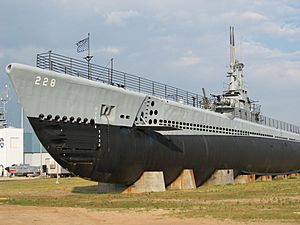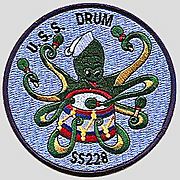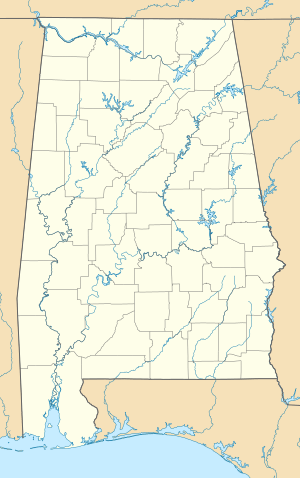USS Drum (SS-228) facts for kids
 |
|
| History | |
|---|---|
| Namesake | Drum, Fish |
| Ordered | 12 June 1940 |
| Builder | Portsmouth Naval Shipyard, Kittery, Maine |
| Laid down | 11 September 1940 |
| Launched | 12 May 1941 |
| Sponsored by | Mrs. Thomas Holcomb |
| Commissioned | 1 November 1941 |
| Decommissioned | 16 February 1946 |
| Stricken | 30 June 1968 |
| Status | Museum ship at Mobile, Alabama |
| Badge |  |
| General characteristics | |
| Class and type | Gato-class diesel-electric submarine |
| Displacement |
|
| Length | 311 ft 9 in (95.02 m) |
| Beam | 27 ft 3 in (8.31 m) |
| Draft | 17 ft (5.2 m) maximum |
| Propulsion |
|
| Speed |
|
| Range | 11,000 nmi (20,000 km; 13,000 mi) surfaced at 10 knots (19 km/h; 12 mph) |
| Endurance | 48 hours at 2 knots (3.7 km/h; 2.3 mph) submerged, 75 days on patrol |
| Test depth | 300 ft (91 m) |
| Complement | 8 officers, 75 enlisted |
| Armament |
|
|
USS Drum (submarine)
|
|
| Location | Mobile, Alabama |
| Built | 1941 |
| Architect | Portsmouth Naval Shipyard |
| NRHP reference No. | 86000086 |
| Significant dates | |
| Added to NRHP | 14 January 1986 |
| Designated NHL | 14 January 1986 |
The USS Drum (SS-228) is a famous Gato-class submarine that served in the United States Navy. It was the first Navy ship to be named after the drum fish. Today, the Drum is a museum ship located in Mobile, Alabama, at Battleship Memorial Park.
The Drum was started on September 11, 1940, at the Portsmouth Naval Shipyard in Kittery, Maine. It was launched into the water on May 12, 1941. Mrs. Beatrice M. Holcomb, whose husband was a Marine Corps general, was the ship's sponsor. The submarine officially joined the Navy on November 1, 1941, with Commander Robert H. Rice in charge.
Even though the Drum was the twelfth Gato-class submarine built, it was the first one finished. It was also the first to enter combat during World War II. It is the oldest Gato-class submarine still around today.
Contents
World War II Adventures of the Drum
First War Patrol
The Drum arrived at Pearl Harbor on April 1, 1942. After a quick trip to Midway Atoll, it left Pearl Harbor on April 14 for its first war patrol. This means it went on its first mission to find and attack enemy ships.
While cruising near Japan, the Drum sank a Japanese ship called the Mizuho on May 2. This ship was a seaplane tender, which means it carried and supported seaplanes. After this, the Drum faced a tough 16-hour attack with 31 depth charges. Depth charges are underwater bombs used to attack submarines.
Later that month, the Drum sank three more cargo ships. It returned to Pearl Harbor on June 12 to get supplies and repairs. For its brave actions, the crew received the Submarine Combat Patrol insignia.
Second and Third Patrols
The Drum's second war patrol was from July 10 to September 2. It sailed between Truk and Kavieng. During this patrol, the submarine had trouble with its torpedoes, but it still managed to damage one enemy cargo ship.
On its third patrol, starting September 23, the Drum headed to the eastern coast of Kyūshū, Japan. On October 8, it found a group of four cargo ships. Despite enemy planes watching, the Drum sank the 5,652-ton cargo ship Hague Maru. This ship was carrying important supplies like wheat, machines, steel, and cars.
The next day, the Drum was heavily attacked with depth charges after sinking another cargo ship, the Hachimanzan Maru. On October 20, it sank the 5,106-ton Ryunan Maru and damaged at least two more ships. The patrol ended at Pearl Harbor on November 8.
Fourth Patrol: A Risky Mission
From November 29, 1942, to January 24, 1943, the Drum took on a very risky mission. It had to plant mines in the busy Bungo Channel. Mines are explosives placed in the water to damage or sink enemy ships.
On December 12, the Drum spotted the Japanese aircraft carrier Ryūhō, which was full of planes. Even though the Drum was taking on water, it fired torpedoes and hit the carrier twice! The Ryūhō tilted so much that its flight deck was fully visible. As the Drum dove deeper to escape, it lost control and one of its engines stopped. It had to make quick repairs while being attacked with depth charges. The Ryūhō managed to escape, but the Drum also damaged a large oil tanker during this patrol.
Fifth and Sixth Patrols
After getting a major repair at Pearl Harbor, the Drum went on its fifth patrol from March 24 to May 13. It searched waters south of Truk and took photos of Nauru. It sank the cargo ship Yuzan (Oyama) Maru on April 9. On April 18, it sank the 6,380-ton cargo ship Nisshun Maru, which was carrying ammunition. After this, the submarine went to Brisbane, Australia, for more repairs.
Its sixth patrol, from June 7 to July 26, took it north of the Bismarck Archipelago. On June 17, it found a group of three ships and sank the 5,086-ton cargo-passenger ship Myoko Maru.
Seventh and Eighth Patrols
After getting supplies in Brisbane, the Drum began its seventh patrol on August 16. On August 28, it damaged the 6,439-ton cargo ship Yamagiri Maru with two torpedoes. This ship was carrying important materials for the war. On September 8, it sank the 1,334-ton cargo ship Hakutetsu Maru #13. The Drum also patrolled near New Georgia during the landings there.
The Drum started its eighth patrol on November 2, helping with the landings at Cape Torokina. While patrolling between the Carolines and New Ireland, it sank the submarine support ship Hie Maru on November 17. On November 22, it attacked a group of four cargo ships. The enemy ships attacked back with three depth charge attacks. The Drum was badly damaged and had to return to Pearl Harbor. It arrived on December 5, and inspections showed that its conning tower (the control room on top) needed to be replaced. This meant it had to sail to the West Coast of the United States for major repairs.
Ninth, Tenth, and Eleventh Patrols
The Drum returned to Pearl Harbor on March 29, 1944. Eleven days later, it began its ninth patrol, searching the waters around Iwo Jima and other islands. It didn't find any major targets, but it gathered important information about Chichi Jima island, which helped later attacks.
The submarine got supplies at Majuro from May 31 to June 24. Then, it went on its 10th patrol to help rescue pilots whose planes were shot down during raids on Yap and Palau. On July 29, it sank a small 125-ton fishing boat called a sampan and captured two prisoners. These prisoners were brought back to Pearl Harbor on August 14. The crew again received the Submarine Combat Patrol insignia.
On September 9, the Drum sailed for Surigao Strait for its 11th patrol. After two weeks with no enemy contact, it was ordered north to the South China Sea. Here, it patrolled during the Leyte landings and the big Battle of Leyte Gulf. On October 24, it sank the passenger-cargo ship Shikisan Maru. Two days later, on October 26, the Drum found a group of 13 ships. It sank two more passenger-cargo ships, the Taihaku Maru and the Taisho Maru, and a transport ship, the Tatsura Maru. It also damaged another ship, the Aoki Maru, which was carrying Japanese soldiers to the Philippines.
Final Patrols and End of War Service
The Drum was repaired at Majuro from November 8 to December 7. Then, it sailed for the Nansei Shoto for its 12th patrol. It only found one enemy ship and returned to Guam on January 17, 1945.
During its 13th patrol, from February 11 to April 2, the Drum helped in the attacks on both Iwo Jima and Okinawa. It provided rescue services for pilots during air strikes on Japanese islands. After returning to Pearl Harbor, the Drum went to the West Coast for another major repair.
After training, it left Midway on August 9 for what would have been its 14th patrol. However, this mission was cut short because Japan surrendered on August 15, ending World War II. The Drum then sailed to Saipan, then to Pearl Harbor, and finally to Portsmouth, New Hampshire.
After the War
The Drum was officially taken out of service on February 16, 1946. On March 18, 1947, it began serving as a training ship for members of the United States Navy Reserve in Washington, D.C.. This continued until 1967. From 1967 to 1969, it was part of the inactive Fleet in Norfolk, Virginia.
Awards and Achievements
The Drum received 12 battle stars for its service in World War II. It is credited with sinking 15 enemy ships, totaling 80,580 tons. This makes it the eighth highest-ranking US submarine in terms of enemy ship tonnage sunk.
The Drum as a Museum Ship
The Drum was given to the USS Alabama Battleship Commission on April 14, 1969. It was then towed to Battleship Alabama Memorial Park in Mobile, Alabama, arriving on May 18, 1969. The Drum was opened to the public as a museum on July 4, 1969.
In 1986, the Drum was named a National Historic Landmark.
The Drum was originally floating in the water behind the battleship Alabama. However, it was badly damaged by the storm surge from Hurricane Georges in 1998. Because of this, it is now displayed on land. Both the Alabama and the Drum were also damaged by Hurricane Katrina in 2005. Tours inside the Drum started again on January 9, 2006. Most of the money to keep the submarine in good condition comes from a group of American Submarine Veterans.
As of 2015, the Drum's restoration has made great progress. Parts of its front and back sections have been completely rebuilt. New support beams have been added inside its ballast tanks to hold up the submarine's weight.
Fun Facts About the Drum
- The Drum's periscope (a device for seeing above water) is pointed directly at the back of the USS Alabama.
- The Drum was used in the 1992 movie Under Siege. In the film, it pretended to be a captured North Korean submarine. The movie also filmed scenes on the Alabama.
- Wayne Green, who started Byte magazine, was once a crew member on the Drum.
Images for kids






